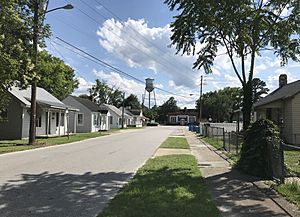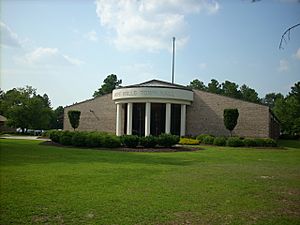Hope Mills, North Carolina facts for kids
Quick facts for kids
Hope Mills, North Carolina
|
|
|---|---|

Street in Hope Mills
|
|
| Motto(s):
"Where Families Live and Grow"
|
|

Location in Cumberland County and the state of North Carolina.
|
|
| Country | United States |
| State | North Carolina |
| County | Cumberland |
| Area | |
| • Total | 8.64 sq mi (22.38 km2) |
| • Land | 8.48 sq mi (21.96 km2) |
| • Water | 0.16 sq mi (0.42 km2) |
| Elevation | 157 ft (48 m) |
| Population
(2020)
|
|
| • Total | 17,808 |
| • Density | 2,100.25/sq mi (810.90/km2) |
| Time zone | UTC−5 (Eastern (EST)) |
| • Summer (DST) | UTC−4 (EDT) |
| ZIP code |
28348
|
| Area codes | 910, 472 |
| FIPS code | 37-32640 |
| GNIS feature ID | 2405861 |
Hope Mills is a friendly town located in Cumberland County, North Carolina, in the United States. In 2020, about 17,808 people lived there. The town's motto is "Where Families Live and Grow," showing its focus on community life.
Contents
Exploring Hope Mills' Location
Hope Mills is in the western part of Cumberland County. It sits just south of Fayetteville, which is the main city in the county.
The town center is right next to a dam on Little Rockfish Creek. This dam creates a beautiful spot called Hope Mills Lake. Little Rockfish Creek then flows into Rockfish Creek, which eventually joins the Cape Fear River.
Getting Around Hope Mills
North Carolina Highway 59, also known as Main Street, goes right through the middle of town. You can drive about 5 miles north on this road to reach U.S. Route 401 in Fayetteville. If you go south for about 2.5 miles, you'll get to Interstate 95 at Exit 41. Some areas around Exit 41 are part of Hope Mills, even if they aren't directly connected to the town center.
Size of the Town
Hope Mills covers a total area of about 8.64 square miles (22.38 square kilometers). Most of this area is land, about 8.48 square miles (21.96 square kilometers). A small part, about 0.16 square miles (0.42 square kilometers), is water, including Hope Mills Lake.
A Look Back at Hope Mills' History
Hope Mills became an official town in 1891. But its story began much earlier, in 1766. Back then, people realized the area had lots of natural water power and plenty of trees. So, they started a lumber camp, a saw mill, a grist mill (for grinding grain), and even a pottery business.
In 1839, something big happened: the first cotton mill was built. It used power from the Hope Mills Dam. This was the start of a new time for the town. The cotton-milling industry became very important, and it even gave the town its name!
Before it was called Hope Mills, the area had other names. People knew it as Little Rockfish Village or Hope Mills Number One.
Civil War Impact
During the Civil War, the local cotton mill and many other buildings were sadly burned down. This happened when General Sherman's troops passed through the area.
Today, two important historical places in Hope Mills are recognized nationally. These are the Big Rockfish Presbyterian Church and the Hope Mills Historic District. They are listed on the National Register of Historic Places.
Life in Hope Mills Today
Even though Hope Mills is not a huge city, it offers many services and fun activities for its residents. You can find public parks and places for sports all around town. These spots have everything from walking trails to tennis courts.
Hope Mills has its own police and fire departments to keep everyone safe. If you need a hospital, there are four major ones just a few minutes away. The county library is new and offers cool programs, like summer reading clubs and meeting rooms for groups.
For shopping, there are five shopping centers, plus the charming historic downtown area. The town also has a post office and two medical clinics. Kids in Hope Mills go to schools like Baldwin, Rockfish, Collier, and Cashwell for elementary school. For middle school, there's South View and Hope Mills Middle. High school students attend South View or Gray's Creek. Plus, there are more than 20 churches in the community.
Hope Mills' Growing Population
Hope Mills has grown quite a bit over the years. Here's a quick look at how its population has changed:
- 1890: 456 people
- 1900: 881 people
- 1910: 964 people
- 1920: 783 people
- 1930: 971 people
- 1940: 900 people
- 1950: 1,077 people
- 1960: 1,109 people
- 1970: 1,866 people
- 1980: 5,412 people
- 1990: 8,184 people
- 2000: 11,237 people
- 2010: 15,176 people
- 2020: 17,808 people
As of the 2020 United States census, there were 17,808 people living in Hope Mills. These people lived in 5,759 households, with 3,834 of those being families.
Famous Faces from Hope Mills
- Cal Koonce: He was a professional baseball player who pitched in Major League Baseball.
See also
 In Spanish: Hope Mills (Carolina del Norte) para niños
In Spanish: Hope Mills (Carolina del Norte) para niños



